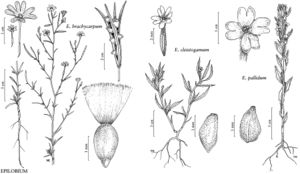Epilobium pallidum
Phytologia 73: 458. 1993.
Herbs with taproot. Stems terete, 4.5–55 cm, simple or with proximal ascending branches and/or distal branches, ± densely villous and/or strigillose, mixed glandular puberulent distally or glabrescent. Leaves opposite only in proximal pairs, alternate and crowded distally, subsessile, blade narrowly elliptic or lanceolate, 1.2–5 × 0.2–1.2 cm, usually longer than internodes, base cuneate to attenuate, margins subentire or sparsely serrulate, 3–5 teeth per side, veins inconspicuous, 2–7 per side, apex acute, surfaces villous; bracts same size and shape as leaves. Inflorescences erect spikes, often congested proximally, sometimes nodding in bud, simple, or sometimes sparsely branched, ± densely mixed villous, strigillose, and glandular puberulent. Flowers erect, mostly chasmogamous, sometimes initiating at second or third proximal node; buds 3–5 × 2.5–3.5 mm, apex blunt; floral tube 1.5–3 × 1.1–2.8 mm, ring of lax hairs near base inside; sepals erect, (1.5–)2–6.2 × (0.5–)1–2.2 mm, densely villous and glandular pubescent abaxially; petals rose-purple, (2.8–)4.2–9.8 × (2.2–)3.5–5.3 mm, apical notch 1.2–3.5 mm; filaments rose-purple, those of longer stamens 2.4–6.5 mm, those of shorter ones 0.9–4.3 mm; anthers 0.6–1.6 × 0.2–0.8 mm; ovary 3.5–9 mm, densely pubescent; style pink, 3.3–9.2 mm, stigma 4-lobed, ± subentire in smaller flowers, 0.7–1.4 × 0.5–1.3 mm, usually surrounded by, rarely exserted beyond, longer anthers. Capsules narrowly fusiform, (10–)14–21 × 1–2.1 mm, beak 2–5 mm, ribs usually broad and prominent, septa and central column disintegrating with age, surfaces ± densely villous; subsessile. Seeds 8–12 per capsule, initially in 4 locules, at maturity pushed into 2 rows proximally, 1 overlapping row distally, irregularly angular-fusiform, 1.8–2.3× 0.7–0.9 mm, chalazal collar absent, surface irregularly reticulate. 2n = 20.
Phenology: Flowering May–Aug(–Sep).
Habitat: Stream banks and washes in vernally moist areas in shrubland or lower forested regions.
Elevation: 60–2100 m.
Distribution
Calif., Idaho, Oreg.
Discussion
P. H. Raven and D. M. Moore (1965) observed that smaller-flowered individuals of this species were sometimes difficult to separate from Epilobium torreyi (reported as Boisduvalia stricta), especially in the absence of mature fruits. The capsules of E. pallidum are usually longer and thinner than those of related species and the internal structure is highly distinctive. The stigmas of larger-flowered plants often are exserted beyond the anthers, increasing the chances for outcrossing.
Selected References
None.
